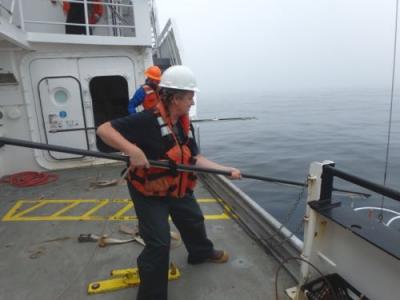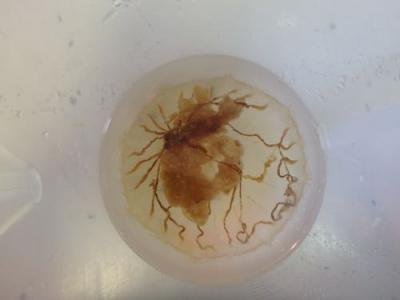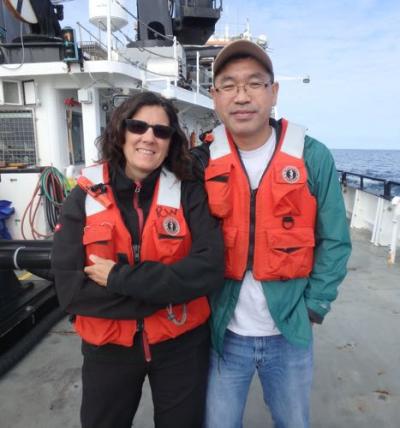The Importance of Teacher/Researcher Collaboration
No book, movie or professional development I have experienced could have produced the effect of actually being in the field engaging in scientific research as a PolarTREC teacher on the “Jellyfish in the Bering Sea” expedition July 27-August 5, 2017. As the PolarTREC teacher, I was tasked with the role of disseminating the ongoing research to the public and I was welcomed as part of the research team. While on the day crew, I worked directly with Dr. Mary Beth Decker in the wet lab as we sampled collections from the tow nets. Although we did this every day several times a day, it never became dreaded or tedious. I found it exhilarating to look at what we gleaned from the water. I was ecstatic to see some familiar looking phytoplankton, such as Cosinodiscus, common to the Chesapeake Bay. Teachers should engage in relevant and meaningful research. I think that research injects passion into our instruction. Our students catch on to our enthusiasm and science becomes contagious.
Summary of the Science, or The Science Explained
The team on the “Jellyfish in the Bering Sea” expedition was comprised of Principal Investigators Dr. Mary Beth Decker and Dr. Hongsheng Bi, Suzan Shahrestani (PhD candidate in Fisheries Science), Benjamin Binder (PhD candidate in Goliath grouper research and acoustics at Florida International University), Jonathan Witmer (Acoustics Technician), Jami Ivory (Research Scientist), Stuart Cook (research specialist) and me, a PolarTREC teacher who hails from Booker T. Washington High School in Norfolk, VA. 
To do this, we used several instruments and techniques. In order to identify and measure adult and juvenile jellyfish, we sampled the water using plankton nets of two different sizes. The ZOOVIS imaging system collected continuous observations of plankton and small jellyfish. The ARIS, a sonar-imaging technology, was used simultaneously with the ZOOVIS to collect information on fish and large jellyfish. The data obtained will be used to construct a model of jellyfish dynamics. By measuring population sizes at different stages, we can estimate the rate of growth within a season. From a population model constructed with our cruise data, scientists can make predictions about how jellyfish respond to changing ocean temperatures and harvesting of commercial fish species. This research will be carried out over two years and there will be sampling in the late spring and summer of each year.
This particular jellyfish, Chrysaora melanaster, is the focus of this research due to its great importance in the food web of the eastern Bering Sea. This voracious jellyfish eats both the food source and the young of commercial fish species, such as walleye pollock. By learning more about and quantifying the survival rates and age-specific abundances of these jellyfish, the research team will be able to devise a model to make predictions of their impact on the eastern Bering Sea food web.
Every few hours, the ship slowed down at a station and we started sampling the water or jellyfish. There are stations, only identifiable by GPS, at which we used the CTD and three tow nets, a large 1-meter net and 2 smaller, 20 cm nets. These two types of nets have different mesh sizes. The 1-meter net is 500 microns and the 20 cm net is 150 microns. These nets are designed to collect different size fractions of plankton. The 1-meter net has an opening large enough to sample the jellyfish, which are rare in relation to other zooplankton such as copepods. These nets were pulled in a very specific angle and as the ship moved slowly, these nets followed an oblique path. 
While these nets were underwater for a few minutes, we got the materials ready to record data. On every data sheet, we had the date, time, station number, volume of water flow and the latitude and longitude. When the tow nets came out of the water, we recorded how much water flowed through them. The net containers were then taken into the wet lab where we identified, measured and preserved the sample in jars marked with the date, station number and geographical location. If there was an organism that we needed to identify, we put the organism under a microscope and used identification keys to make a decision about what species it is.
Ultimately, these samples will be analyzed in the lab with the aid of a microscope. Dr. Mary Beth Decker and her team at Yale University will count and identify all of the organisms in each sample. From this information, the scientists can estimate the abundance of each species at each station. By analyzing these samples, the scientists can see if the samples correlate with the ZooVis images in terms of numbers and species observed during the transect.
Bringing the PolarTREC Science Back to my Classroom and Community
Since returning from the PolarTREC expedition, I have made arrangements to present later this year at STEM events, one for the Girl Scouts and the other for Boy Scouts, at Nauticus, a museum related to ocean science in downtown Norfolk, VA. My proposal for the Virginia Association of Environmental Educators Conference was accepted, but administrative approval by my school is pending. I am also looking into presenting at a few senior citizen centers.
As I am teaching Biology as well as Earth Science, I will be able to easily integrate my PolarTREC experience into instruction. I would also like to have my students in AP Biology participate in research pertaining to seasonal jellyfish abundances in the Chesapeake Bay. My students in AP Biology will engage in inquiry-based, team-oriented labs, which is more like scientific research in the real world. I want them to realize that science inquiry is not following a well-tested recipe.
What are three to five things which I expected to learn during my experience?
- I expected to learn about technology used in research. This is important because I want my students to ask “why” and “how do they know that?” and I want to be able to answer my students. Students will learn from my experience the role of technology and its importance in obtaining data. I was able to get hands-on experience with technology and all on the science team were forthcoming with information of how they used technology to further understanding of the research question.

Principal Investigators Dr. Mary Beth Deck and Honsheng Bi. - I expected to gain a deeper understanding of the “nature of science”. The logistics meeting I attended in April was a testament to the careful planning scientists use in order to ensure valid and reliable data. I want to convey this to my students. I was able to witness firsthand how all on the team followed established protocol even in the face of difficulty (driving rain and seasickness).
- I expected to learn the importance of teamwork and delegating responsibilities. This is essential for students to understand as they carry out group projects. I saw teamwork as we helped each other out as needed.
- I expected to learn about climate change and how we can measure its effects. My students have no qualms when it comes to the study of climate change. It is very evident in this area of imminent sea level rise. Through discussing the research, students can learn how climate change affects ocean life and food web dynamics. I had the great fortune to sit next to an Aleut public school teacher who has lived in the Aleutian Islands all her life. She recounted the changes she had seen with climate, fishing and vegetation.
What were the three to five concepts I would like to teach "better" or differently? How does this impact my students?
- I want to improve how I teach Earth Science and Biology by embedding each aspect I teach in the context of a system. Students need to know how systems affect one another, for example, how a warming atmosphere affects the frequency and intensity of extreme low pressure events and the organisms in a food web.
- I want to teach Earth Science and Biology and their importance to students’ lives. Earth Science and Biology should be more than just verified science credits to students. If students become engaged through more inquiry-based projects, they will assimilate the content more meaningfully.
- I want to teach the nature of science as a means of approaching something not fully understood. Ignorance should not be seen as something negative; rather, ignorance should be viewed as a driver for exploring natural phenomena. Through my teaching, I want to improve how I teach content by letting students know that it’s permissible not to be able to observe something directly (a black hole) but make inferences about it by observing reactions around it.
From your outreach plan, are there any activities that you will pursue, post-expedition, that the public should know about?
I would like to engage my students in long-term research pertaining to the Chesapeake Bay. In our Earth Science class, we learn about the Gulf Stream and how it is warming and as a result, expanding. This expansion of warming water is one of the many factors involved in our so-called “nuisance” flooding, which we all experience. We also have a sea nettle species in our bay, which tends to bother the tourists. How has our warming Chesapeake Bay affected our sea nettle population? How does the warming bay affect HAB events? Food webs? I would like for my students to know enough to ask these and other questions which could lead to long-term research.
| Attachment | Size |
|---|---|
| Download Report (893.64 KB)893.64 KB | 893.64 KB |
This program is supported by the National Science Foundation. Any opinions, findings, and conclusions or recommendations expressed by this program are those of the PIs and coordinating team, and do not necessarily reflect the views of the National Science Foundation.
